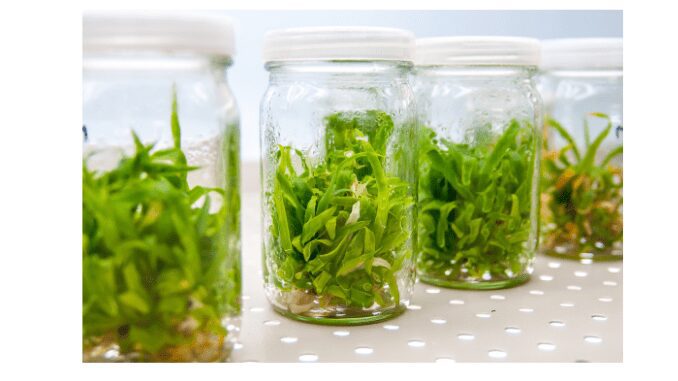
Plant Tissue Culture
Plant regeneration via plant tissue culture is often the most critical step in the success of biotechnological strategies for any plant improvement program. It involves the production of true-to-type plants in large numbers in a short period. Uses extremely small populations and offers a method to increase valuable genotypes.
It can be defined as a collection of techniques used to maintain or grow plant cells, tissue, or organs under sterile conditions on a nutrient medium of known composition. It is widely used to produce clones of plants and the method is known as micropropagation. This technique is helpful in the production of selected plants of known desirable agriculture qualities. Produces a large number of plants from small pieces of plant in relatively short periods of time under controlled disease-free conditions.
The explants may be taken from the shoot tip, leaf, lateral bud, stem, or root tissue of the mother plant. These ex-plants go through the initiation, multiplication, and rooting methods for producing a cell into a full-fledged plant. These ready plantlets are then hardened in climatically controlled greenhouses or polyhouses.
In vitro propagation (Production in the laboratory under sterile and controlled conditions) also ensures the easy maintenance and availability of pathogen-free clones throughout the year. In recent years this trend is likely to continue as many of the species are facing the risk of extinction.
Moreover, it is being widely used for several medicinal plants, particularly for mass propagation, production of bioactive compounds, and genetic improvement.
Pathways of cultured cells and tissues
The cultured cells and tissue can take several pathways to produce a complete plant. Among these, the pathways that lead to the production of true-to-type plants in large numbers are the popular and preferred ones for commercial multiplication.
The following terms have been used to describe various pathways of cells and tissue in culture (Bhojwani and Razdan 1983).
Organogenesis in plant tissue culture
- In this pathway, groups of cells of the apical meristem in the shoot apex, axillary buds, root tips, and floral buds are stimulated to differentiate and grow into shoots and ultimately into complete plants.
- It is one of the widely used methods employed for in vitro plant regeneration.
- Plant growth regulator regimes can be used to manipulate the morphogenetic response of plants under in vitro cultures (Giri and Giri 2007).
- There are two types of shoot organogenesis, direct and indirect.
- Direct shoot organogenesis is the production of shoots from explants directly, while indirect refers to the formation of shoots indirectly from an intermediary callus that first develops on the explants (Kane et al. 1994).
Somatic Embryogenesis in Plant Tissue Culture
- Somatic embryogenesis is a process in which a bipolar structure, resembling a zygotic embryo, develops in vitro from a non-zygotic cell without vascular connection to the original tissue.
- They are used to study the regulation of embryo development and are a tool for large-scale vegetative propagation (Arnold et al. 2002).
- Embryos formed in cultures are referred to as embryoids, supernumerary embryos, adventives embryos, or accessory embryos. Of these, the term embryoid is used most widely (Bhojwani and Razdan 1983).
There are two different patterns of the origin of somatic embryos from in vitro grown explants (Sharp et al. 1980, Williams and Maheswaran 1986).
1) Direct production of somatic embryos from the cells of the explant called the pre-embryogenic-determined cells (PEDC)
Somatic embryos in the direct production of somatic embryos are presumed to originate from explant cells that require only in vitro environment to be released from some repressive condition composed by the organization of the explants.
2) Indirect production of somatic embryos from unorganized callus tissue mass called the induced embryogenic determined cells (IEDC).
IEDC pattern is the indirect production of somatic embryos that not only requires the release of the previously differentiated state through mitotic cell divisions but also induction of the new pattern of cell divisions to form organized embryos.
Applications
1. Basic applications
1. Genetics
- Somatic cell genetics
- Mutation
- Polyploidization
2. Host-pathogen studies
- Obligate Parasites
- Plant tumor
3. Morphogenesis
2. Economic Applications
1. Micropropagation
- Clonal propagation
- Production of pathogen-free plants or crop improvement
- Transgenic crops
- Health-promoting crops
2. Plant conservation
- The role of tissue culture in preserving threatened and endangered plant species
3. Commercial applications
- Micropropagation
- Production of somatic hybrids and cybrids
- Plant-made pharmaceuticals
- Edible vaccines
- Dihaploid production of plants from haploid cultures
- Production of secondary metabolites
4. An efficient method of saving space and energy
The method saves space and energy for the farmer as the whole technique needs a laboratory, not a field like farmers to use in their conventional methods. For example, in a conventional method, the plants are grown in the open farm requiring an area of about 25,000 m2, the same number of plants would require only 10 m2 space if they are grown in the tissue culture laboratory.
5. Haploid culture
The development of haploids through the technique of anther culture has a potential significance in basic and applied genetics and plant breeding.
6. Embryo culture
embryo culture has been useful in overcoming seed dormancy. It is also utilized for producing viable plants from crosses, which normally fail due to the death of immature embryos. The embryo tissue culture is also applied for the propagation of rare plants.
